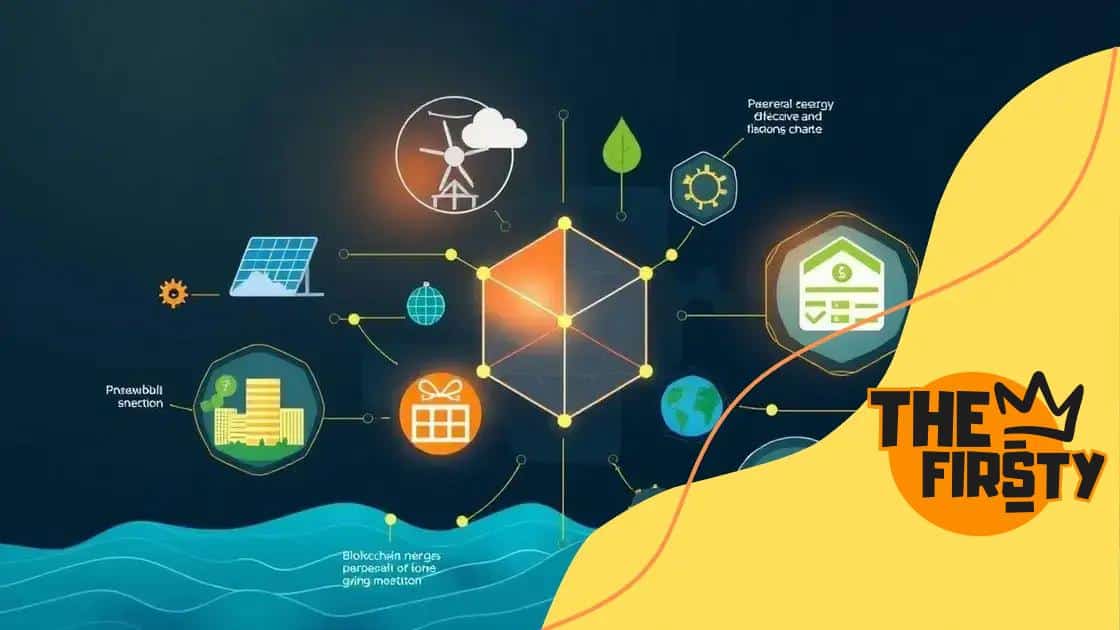Blockchain-based solutions for fighting climate change

Anúncios
Blockchain-based solutions for fighting climate change enhance transparency, improve accountability, and facilitate sustainable practices, making them essential for achieving environmental goals.
Blockchain-based solutions for fighting climate change are emerging as innovative tools in the battle against our planet’s climate crisis. But how can this technology truly make a difference? In this article, we’ll dive into its potential and real-world impact.
Anúncios
Understanding blockchain technology
Understanding blockchain technology is crucial for grasping how it can impact various fields, including sustainability. At its core, blockchain is a decentralized and distributed ledger that records transactions across many computers effectively, ensuring that the registered transactions cannot be altered retroactively. This quality is particularly relevant when applied to the challenges of climate change.
Key Features of Blockchain
There are several key features that make blockchain unique:
- Decentralization: No single entity controls the network, reducing the potential for corruption and fraud.
- Transparency: All participants can view transactions, which enhances trust.
- Immutability: Once data is added, it cannot be changed, ensuring data integrity.
These characteristics allow blockchain to provide measurable benefits in environmental initiatives. For instance, by creating a transparent system for tracking carbon credits, organizations can engage in fair trading, promoting accountability in emissions reduction efforts. When companies know that their actions are visible, it pushes them to act responsibly and sustainably.
Anúncios
How Blockchain Works
The technology operates through a network of computers (nodes) that validate transactions before they are added to the blockchain. This process is known as consensus. Different consensus mechanisms exist, like Proof of Work or Proof of Stake, with each providing distinct benefits depending on the application.
Furthermore, this technology enables smart contracts, which are self-executing contracts where the terms are directly written into code. These contracts automate and secure transactions without intermediaries, which can significantly reduce costs and improve efficiency.
Incorporating blockchain into climate initiatives enhances collaboration among stakeholders. For example, NGOs, governments, and corporations can share verified data about emissions and energy consumption in real time. This fosters innovative solutions and encourages cooperative efforts towards sustainable practices.
Potential Use Cases
Several use cases illustrate how blockchain technology can influence climate action:
- Supply chain monitoring for sustainable sourcing.
- Carbon trading mechanisms that promote fair exchanges.
- Verification of renewable energy credits to support clean energy projects.
By understanding these mechanisms, we can unlock blockchain’s vast potential in mitigating climate change. Its versatile applications create opportunities for greater accountability and transparency, making it a powerful tool in the fight against environmental degradation.
How blockchain enhances transparency in environmental initiatives
How blockchain enhances transparency in environmental initiatives is a crucial aspect of fighting climate change. By providing an immutable record of transactions, blockchain elevates trust among stakeholders. This transparency is vital in maintaining accountability for environmental commitments.
Benefits of Transparency
Transparency in environmental initiatives allows organizations to verify their claims. This is key for:
- Building Trust: Stakeholders feel more secure when they can see real-time data.
- Encouraging Accountability: Participants understand that their actions are visible to others.
- Boosting Collaboration: Transparency fosters partnerships between governmental and non-governmental organizations.
When organizations publicly share data about their sustainability practices, it leads to greater public confidence. This is increasingly important in today’s world, where consumers prioritize sustainability. Observing a company’s efforts through a transparent system helps consumers make informed choices.
Real-world Applications
Various projects utilize blockchain technology to ensure transparency in environmental efforts. Here are a few examples:
- Tracking the origin of sustainable products, such as coffee or chocolate.
- Monitoring carbon credits exchanges to ensure compliance and ethical trading.
- Documenting renewable energy usage in real time, enhancing grid management.
These implementations not only help protect the environment but also create a culture of openness. A transparent approach enables communities and organizations to work together towards shared sustainability goals.
People are more likely to support initiatives that are clear and traceable. When there’s clarity on where investments are going and the positive impact they yield, community buy-in becomes stronger.
Real-world examples of blockchain combatting climate change

Real-world examples of blockchain combatting climate change demonstrate the technology’s transformative potential. Various organizations are leveraging blockchain to create solutions aimed at environmental preservation. These initiatives not only track resources but also promote accountability.
Case Studies in Action
Several notable projects showcase how blockchain is effectively used in environmental efforts:
- Energy Web: This organization utilizes blockchain to facilitate the development of decentralized energy grids, enabling renewable energy sources to operate independently.
- Provenance: Provenance is a platform that helps consumers trace the origin of products, ensuring ethical and sustainable sourcing. This transparency boosts consumer trust and engagement.
- Myco: Myco tracks carbon credits through blockchain, allowing for fair trading and ensuring that emissions reduction claims are verifiable and trustworthy.
These examples underscore the practical applications of blockchain technology in sustainability. By enhancing visibility and providing trustworthy data, these projects help drive efforts to combat climate change.
Impacts on Policy and Regulation
Blockchain’s role extends to influencing environmental policies as well. Governments can use the data provided through blockchain for better regulation of resource use. Agencies can integrate these insights into their decision-making processes, making environmental regulations smarter. Efficient tracking leads to timely actions, such as supporting renewable energy incentives based on verified usage data.
This technology is reshaping how initiatives are launched and reported. Stakeholders can easily verify claims, which can lead to enhanced funding opportunities for green projects. Furthermore, the use of blockchain encourages collaboration among various sectors, creating networks that unite businesses, consumers, and governments in the quest for sustainability.
Through these real-world examples, we see the growing recognition of blockchain’s potential to make substantial contributions to climate action. Innovative approaches help in creating sustainable systems that benefit both the economy and the environment.
Challenges in implementing blockchain for sustainability
Implementing blockchain for sustainability presents several challenges that must be addressed. While the technology offers many benefits, some hurdles can hinder its widespread adoption. Understanding these challenges is key to effectively utilizing this tool in environmental initiatives.
Technical Challenges
The technical aspects of blockchain can be complex. For instance, scalability is a significant concern. As more users join the network, the system can slow down, making it less efficient. Furthermore, issues related to energy consumption arise, especially with certain consensus mechanisms. These operational inefficiencies can detract from the green goals that blockchain aims to support.
Regulatory and Compliance Issues
Navigating regulatory frameworks can also be difficult. Different countries have varying laws regarding blockchain technology. This variability can create confusion for organizations trying to implement sustainable solutions. Moreover, ensuring compliance with data privacy laws while maintaining transparency can present additional challenges.
- Data security: Safeguarding sensitive information is necessary to build trust.
- Interoperability: Ensuring that different blockchain systems can communicate is essential for broader adoption.
- Standardization: Establishing universal standards for blockchain applications will facilitate implementation.
Alongside these factors, the gap in knowledge among stakeholders can impede progress. Many organizations may lack expertise in blockchain technology and its potential environmental applications. Education and training will be crucial to overcome this barrier.
Cultural and Social Resistance
Another challenge is the cultural resistance to change. Many organizations rely on traditional methods of operation. Convincing them to adopt new technologies like blockchain takes time. Organizations must be educated about the potential benefits and how blockchain aligns with their sustainability goals.
Challenging as these hurdles may be, addressing them head-on is vital. To fully leverage blockchain technology in sustainability, collaboration among stakeholders will be necessary. Governments, businesses, and communities need to work together to solve these issues and pave the way for innovative environmental solutions.
Future potential of blockchain in environmental protection
The future potential of blockchain in environmental protection holds great promise as the world continues to confront climate change. This innovative technology can drive significant changes in how we manage natural resources and reduce carbon footprints. By leveraging its inherent qualities, we can create a more sustainable future.
Innovative Applications
There are several exciting areas where blockchain can make a marked difference:
- Decentralized Energy Grids: Blockchain can facilitate peer-to-peer energy trading. Households with solar panels could sell excess energy directly to neighbors, promoting renewable energy use.
- Supply Chain Transparency: By using blockchain, companies can track the origin of their products, ensuring they are sourced sustainably. This greater transparency helps consumers make more informed choices.
- Carbon Credit Tracking: Blockchain can streamline the trading of carbon credits, making the process more efficient and traceable. This ensures companies are held accountable for their emissions.
These applications position blockchain technology as a key player in environmental initiatives. As adoption grows, innovative solutions will emerge, enabling organizations to operate more sustainably.
Integration with Other Technologies
Moreover, integrating blockchain with other technologies, like the Internet of Things (IoT) and artificial intelligence (AI), can enhance its effectiveness. IoT devices can collect real-time data about energy consumption or pollutant levels, which can then be recorded on a blockchain. This combination provides an accurate picture of environmental impacts, allowing for smarter resource management.
Additionally, AI can analyze this data to identify trends and predict future environmental issues. These insights can guide organizations in making strategic decisions that benefit both their operations and the planet.
Policy and Collaboration Opportunities
The future of blockchain in environmental protection may also involve increased collaboration between governments, businesses, and NGOs. Policies that promote the adoption of blockchain technology can lead to shared platforms where data is accessible and transparent. This openness encourages cooperation among stakeholders, working towards common sustainability goals.
As more examples of successful implementations emerge, businesses will likely be motivated to embrace blockchain as a viable solution for enhancing their environmental impact. This collective push can significantly contribute to global climate efforts, making it essential to support these initiatives.
FAQ – Frequently Asked Questions about Blockchain in Environmental Protection
How does blockchain enhance transparency in environmental initiatives?
Blockchain provides a public ledger that ensures all transactions are visible and traceable, boosting trust among stakeholders.
What are some real-world examples of blockchain being used for sustainability?
Projects like Provenance and Energy Web showcase how blockchain can track product origins and facilitate decentralized energy trading.
What challenges does blockchain face in environmental applications?
Challenges include scalability, regulatory compliance, and the need for education among stakeholders about the technology.
What is the future potential of blockchain in environmental protection?
The future is promising, with opportunities for integration with IoT and AI, enhancing resource management and sustainability efforts.





